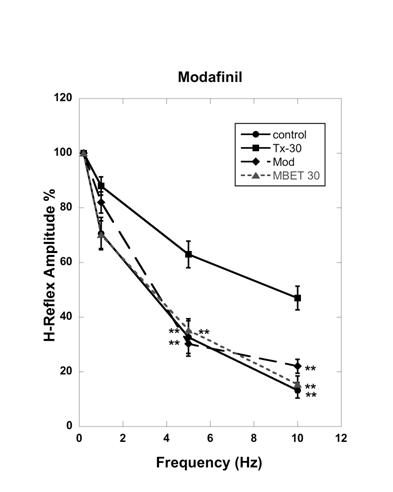Charlotte Yates, Ph.D., PT, PCS
Hyperreflexia occurs after spinal cord injury (SCI) and can be assessed by measuring low frequency-dependent depression of the H-reflex. Previous studies showed that passive exercise could both prevent, if therapy began before the onset of, and correct, if therapy began after the onset of, hyperreflexia in spinal cord transected adult rats. Changes in the neuronal gap junction protein connexin(Cx)-36 were observed. We attempted to determine if treatment with the agent modafinil, used for the treatment of narcolepsy and found to increase electrical coupling, would affect low frequency-dependent depression of the H-reflex in spinalized rats. Spinal Cord Injury Mobilization Program of the Center for Translational Neuroscience, Stephens Spine & Neuroscience Institute, Little Rock, AR, USA. Adult female rats underwent transection at the T10 level. Groups of transected rats were treated with passive exercise for 30 days, modafinil (4 mg/kg/day po) for 30 days, or untreated for 30 days. H-reflex habituation and Cx-36 protein levels were measured at the end of treatment. Significant decreases in low frequency-dependent depression of the H-reflex were observed in exercised and modafinil-treated animals. No changes in whole tissue Cx-36 levels were observed. The stimulant modafinil, known to increase electrical coupling, normalized hyperreflexia as measured using the H-reflex, to the same extent as passive exercise. Changes in Cx-36 whole tissue levels may not be indicative of changes in spinal circuitry leading to amelioration of reflexes. Treatment with modafinil may be effective in reducing hyperreflexia after SCI and other conditions.

